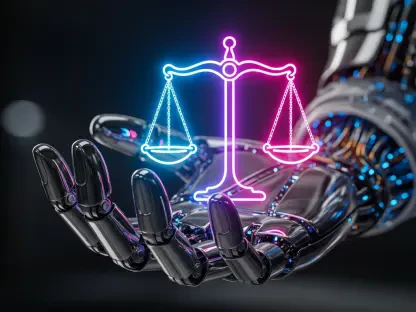Overview of AI in the Judicial Landscape
In a rapidly evolving digital era, the judicial system in England and Wales stands at a critical juncture with the integration of artificial intelligence (AI) technologies, particularly following the updated guidance issued on October 31, 2025. Courts and tribunals are increasingly encountering AI tools, from generative chatbots to administrative aids, promising efficiency but posing significant ethical and practical dilemmas. This development raises a pressing question: how can the judiciary harness AI’s potential without compromising the sanctity of justice? The latest guidance addresses this challenge head-on, offering a framework for judicial office holders, support staff, legal representatives, and even litigants to navigate this technological shift.
The scope of AI application within the legal sphere is vast, touching on everything from drafting documents to summarizing complex case materials. Yet, the judiciary recognizes that unchecked reliance on such tools could undermine public trust and the accuracy of legal proceedings. This pivotal moment underscores the need for clear directives to balance innovation with integrity, setting the stage for a detailed exploration of how AI is reshaping judicial processes while maintaining the core principles of fairness and accountability.
Detailed Analysis of AI Integration in the Judiciary
Core Themes and Recommendations
Key Principles for Responsible AI Use
The updated guidance serves as a cornerstone for judicial office holders, aiming to ensure that AI is employed responsibly without jeopardizing the legal process. It outlines acceptable uses, such as summarizing lengthy texts or aiding in administrative tasks like email drafting, while explicitly cautioning against reliance on AI for legal research or analysis due to concerns over accuracy. This framework prioritizes the protection of justice’s integrity, emphasizing that technology should support, not supplant, human judgment.
Beyond judges, the guidance extends its relevance to clerks, judicial assistants, and indirectly to legal professionals and litigants, fostering a culture of transparency. By making these directives publicly accessible, the judiciary seeks to build confidence among stakeholders that AI will be handled with the utmost care. This broad applicability reflects a commitment to aligning technological advancements with the ethical standards expected in legal environments.
Risks and Limitations of AI Tools
Despite AI’s potential, the guidance highlights significant risks, including inaccuracies and fabrications—often termed “hallucinations”—that can occur with tools like ChatGPT or Google Gemini. These errors, stemming from predictive algorithms rather than authoritative legal databases, pose a threat to the reliability of judicial outcomes. Additionally, biases embedded in AI training data could skew results, necessitating vigilance to uphold fairness.
Confidentiality remains a paramount concern, as entering sensitive information into public AI platforms risks public exposure. The guidance advises against such practices and suggests safeguards like disabling chat history features and using work-specific devices. Moreover, it stresses the importance of independent verification, holding individuals accountable for any AI-generated content to ensure that judicial decisions remain grounded in accuracy.
Challenges in AI Adoption
Implementing AI within judicial processes is fraught with practical hurdles, including the risk of misuse leading to erroneous legal rulings. The absence of authoritative legal databases in public AI tools exacerbates this issue, making it difficult to trust outputs without extensive cross-checking. Ethical dilemmas also arise when AI-generated errors or manipulations go undetected, potentially compromising case integrity.
Technological barriers further complicate adoption, as many judicial staff may lack familiarity with AI’s nuances, increasing the likelihood of oversight failures. To address these issues, the guidance advocates for comprehensive training programs to equip personnel with the necessary skills. Enhanced scrutiny of AI-generated submissions in court proceedings is also recommended to catch discrepancies early.
Regulatory and Ethical Framework
The judiciary has established a robust regulatory stance, prohibiting the input of sensitive data into public AI tools to safeguard privacy. This directive is paired with an ethical mandate to remain vigilant against AI’s inherent biases, ensuring that outputs are cross-referenced with unbiased resources. Such measures aim to maintain equity in legal proceedings, preventing technology from skewing justice.
Accountability forms the bedrock of this framework, with judicial office holders and legal representatives tasked with verifying AI content before use. This personal responsibility ensures that technology does not erode the human element central to legal decision-making. The guidance reinforces that fairness must prevail, regardless of the tools employed, aligning with broader ethical standards in the legal profession.
Future Outlook for AI in Courts and Tribunals
Looking ahead, AI’s role in the judiciary is poised for evolution, with advancements potentially enhancing efficiency in case management and administrative duties over the next few years, from 2025 to 2027. Emerging technologies could streamline workflows, but they also introduce new risks, such as deepfakes or hidden prompts that manipulate content. Staying ahead of these challenges will require continuous adaptation and foresight.
Global trends and regulatory developments will likely influence how courts integrate AI, with international debates on ethics shaping local policies. Ongoing education for judicial staff and legal professionals will be crucial to keep pace with technological disruptions. The balance between leveraging AI for operational gains and preserving the essence of justice will remain a central focus in this dynamic landscape.
Reflections and Forward-Looking Strategies
The exploration of AI’s integration into the judicial system revealed a cautious yet progressive stance, as evidenced by the comprehensive guidance issued in 2025. It became clear that while AI offered tangible benefits in enhancing efficiency, the risks of inaccuracy, bias, and privacy breaches demanded stringent oversight. The judiciary’s commitment to accountability and ethical use stood out as a guiding light amid these complexities.
Moving forward, stakeholders were encouraged to prioritize robust training initiatives to build technological competence among judicial personnel. Establishing rigorous verification processes for AI outputs was seen as essential to mitigate errors, alongside the development of stricter ethical guidelines to address emerging challenges. These actionable steps aimed to ensure that technology served as a tool for justice, not a barrier, paving the way for a future where innovation and integrity coexisted harmoniously in courts and tribunals.









